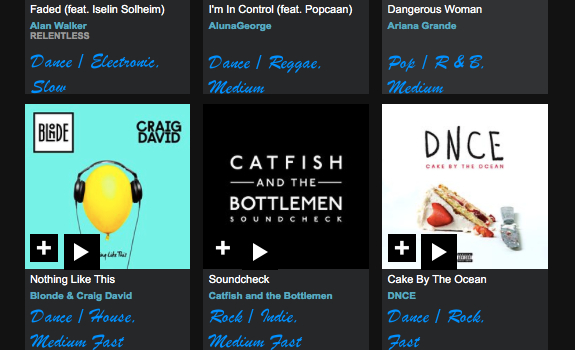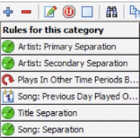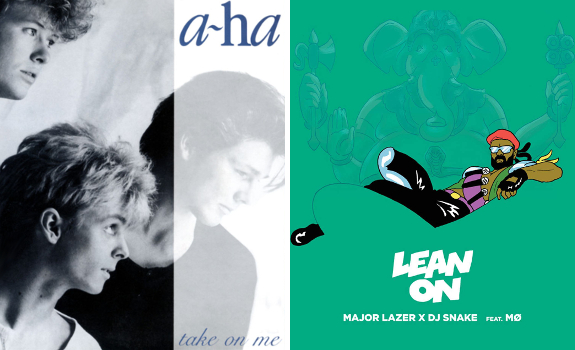While you’re setting music scheduling rules like genre & artist separation for good reason, sometimes you can loosen up or break those rules for good reason.
After part 2 of our interview with Robert Johansson on music scheduling for Contemporary Hit Radio (CHR) formats, here’s the third instalment of a mini series on how to build a great music format for your Top 40 station. How to balance your music output versus your music cycle, and why to skip some format rules at the right moment? “Adele is Adele.”
“Create your categories in a way that represents what you want to communicate”

From Reggae-feeling Dance to Indie-sounding Rock and from slow ballads to uptempo tracks, the A current list of BBC Radio 1 (screenshot taken in mid April 2016) includes a variety of genres & styles, making it easier to schedule these high-rotating power currents in combination with lower-rotating secondary songs (image: BBC / Thomas Giger)
Insert Recurrents for balance
How important is variety on a CHR station?
“It is important, although harder for Top 40 stations as they’re playing the hits of the moment. Sometimes it’s more Rhythmic; sometimes it’s more Pop, and sometimes you have a situation where Adele is on top of the charts with 2 ballads, which will alter the overall feeling of the station.” His advice is to balance your current song playlist with Recurrents, and to platoon a part of your Recurrent back catalog [depending on which ones you need based on the current music cycle]. “Usually, stations have a clear goal based on strategic research on what kind of music styles they want to be associated with.”
 Use category-dependent scheduling rules
Use category-dependent scheduling rules
Johansson does use sound codes for music variety as well, but points out that scheduling rules based on sound not always work for high-rotation categories, like Power Currents that may appear over 100 times a week. He therefore likes to schedule the most-played songs with less rules, and instead use more rules with Recurrents that balance the music flow — as long as these songs match the overall music strategy.
Define music genre percentages
So when the current music cycle is, for example, Dubstep, you want to balance it with, for example, some Pop and Pop-Rock.
“I think so. Usually it’s quite natural. When setting up rules in your music scheduling software, you commonly set quotas for different music styles. If you have a lot of material with a certain sound in your ‘A’ Current and Stay Current lists, which are some categories that you’ll schedule first, then when you start scheduling your Recurrents, songs with these sound codes will not be scheduled anyway. That’s a problem, because when you have songs that are rarely scheduled due to rules, you will have some other songs that will play more than you really want. It’s very important to create your categories in a way that represents what you want to communicate with the station.”
“I’m not sure if that’s a perfect fit”

Going from A-Ha ‘Take On Me’ to Major Lazer ‘Lean On’ (without a talk break or station imaging in between) does not guarantee the best musical transition that you want to achieve (images: Warner Bros., Warner Music Group)
Focus on music popularity
Tempo is a very important part of a CHR station in terms of image. How do you look at tempo? And how do you deal with all those Adele songs?!
“Hahaha, I’d say: Adele is Adele. Many stations are afraid of playing these low-tempo songs, and I usually agree with them, but Adele is special. Hello was instantly a high-testing song; it took a week and everybody knew about it. She’s really unique when it comes to where she fits, and very talented. Traditionally, she’s not a CHR artist, but she’s beyond that. I think it’s good that something happens in the music arena, so you don’t have songs sounding the same from year to year. One of the problems I see format-wise, is that Top 40 and Hot AC stations are getting closer and closer to each other. The differences between them are not as big as they used to be.”
 Own ‘current music’ images
Own ‘current music’ images
What if you’re programming a CHR and not only compete with another Top 40 station, but you have also 2 Hot AC’s in your market, competing both with each other and with you?
“And all stations play the same songs… (smiles). Then you’ll get higher burn quicker, haha. You’d better be first in your format, and own all of the images! I’d like to see slightly more difference between the formats in general.”
Cluster compatible music categories
But people might hear that a Hot AC still plays A-Ha’s Take On Me, Duran Duran’s Ordinary World or a 2000s classic, apart from current hits?
“I work with a Hot AC station that decided to drop everything that’s older than 12 years. Definitely anything from the 90s is out. Another station I know well did this two years ago. Both have been successful in doing that. I’m not saying: that’s the way to go for all stations — definitely not — but I think it’s easy to be known for something by being consistent. Playing A-Ha back to back with Major Lazer… I’m not sure if that’s a perfect fit. Or with Justin Bieber of whoever it is.”
“If you would listen to every person, you could not play any song”

Songs with a mass appeal across many music formats and audience demographics are rare (image: XL Recordings)
Make artist separations relative
How to handle all those Justin Bieber hits? He recently was in the Top 10 with like 3 different songs! Same with Pharrell, about 1 year ago.
“Artist separation is becoming less of a factor. A couple of years ago, stations could have much longer artist separation settings than they have today. Especially if you are in a Rhythmic format, it’s hard with all these ‘featuring artists’. One thing we have been doing, is set a percentage of how much people really think that this artist is in this song. David Guetta songs and Avicii songs have a similar sound, but it could be another vocalist. So what are you separating?” Johansson advises to decide about artist separation on a song-by-song basis, in relation to all other active songs in your music universe.
 Add new songs strategically
Add new songs strategically
A lot comes down to setting up your music categories the right way: “Look at what kind of music you have, and think about what kind of music you need. When you’re looking at new songs to add, it’s all about: what kind of music will help us most? Of course, some songs are important for every radio format. And when Adele comes out with a ballad, and so does a less familiar artist, then sorry… the other won’t make it.”
Play versions that fit
What do you think of stations who don’t want to play the ballad version of Adele, and use a remix version of Hello instead? Can you get away with it, or should you play the original?
(Smiles) “Personally, I think that the Adele-mix with a beat was good, haha. I played it at a station, as it suited that environment.” Johansson’s advice is to keep in mind what people expect from your station, while pointing out that there are always listeners who prefer the original, so you can’t please everyone: “If you would listen to every person, you could not play any song”. He’s attended auditorium music tests where you can see results in real time, as listeners are rating songs with an electronic interface. “For every single song, some people love it — and some people hate it. If you would play only songs that everybody loves, your playlist would be really, really short.”
Thanks to Robert Johansson of Better Radio Programming for this interview. More music scheduling tips for Top 40 (CHR) radio stations & formats will follow in the upcoming part 4, and here’s more to enjoy right now.





Add Your Comment